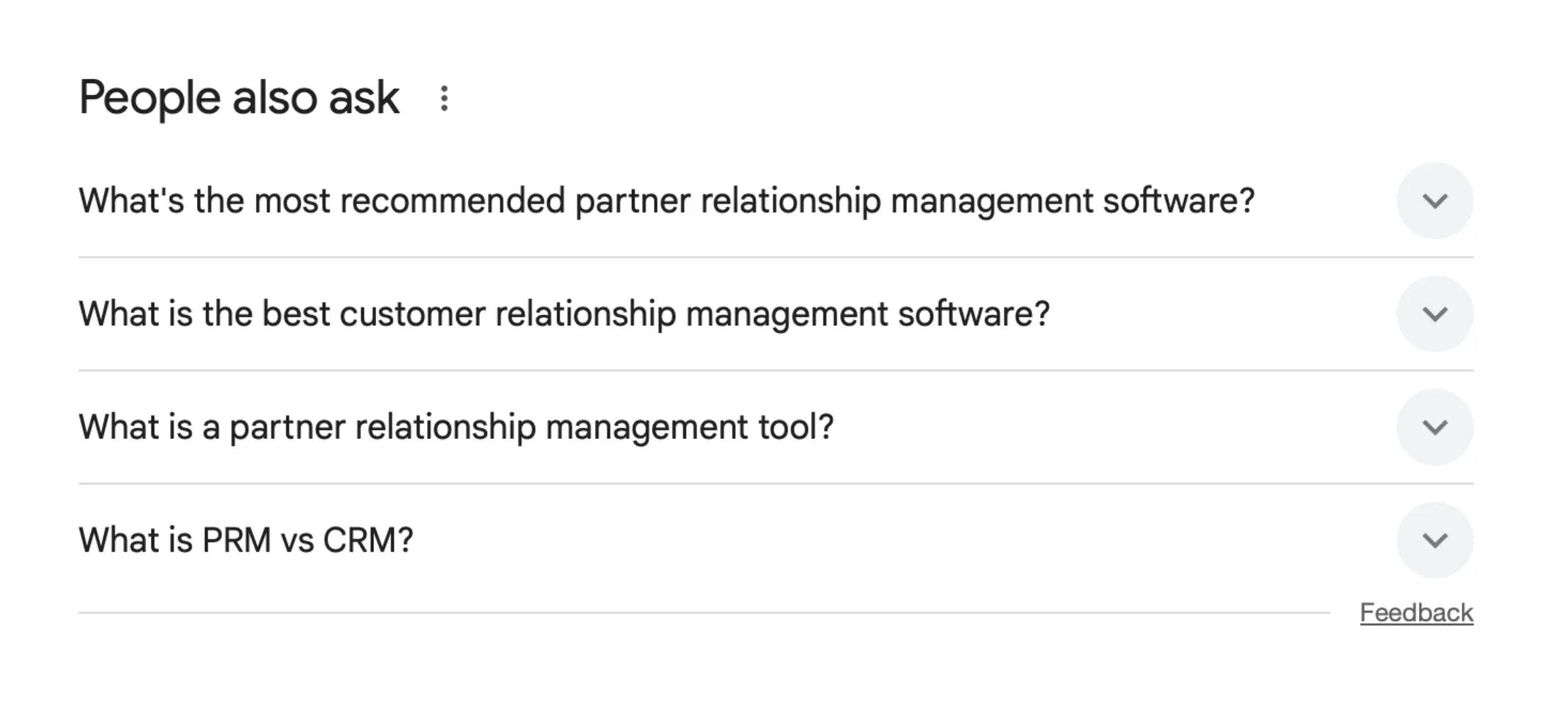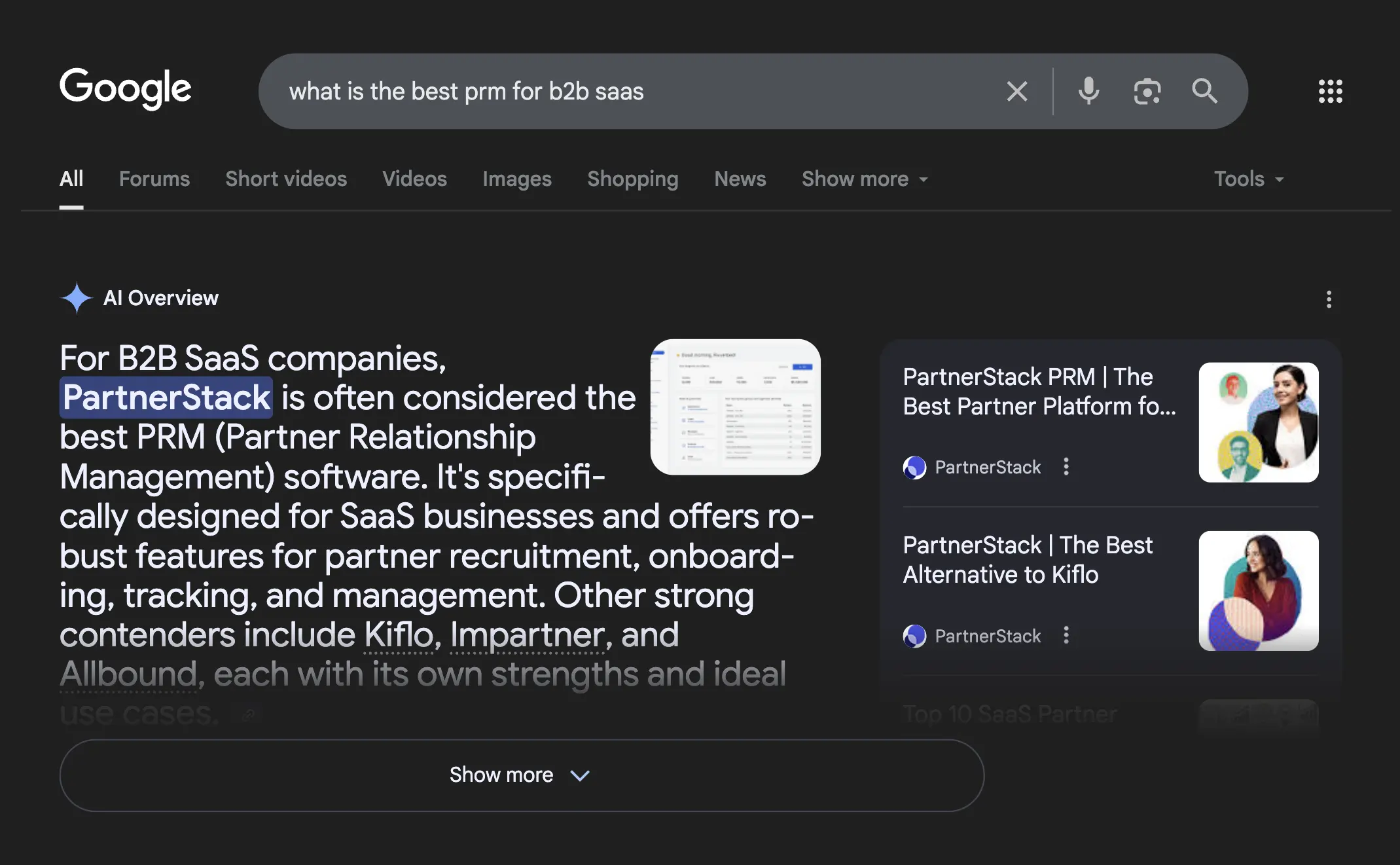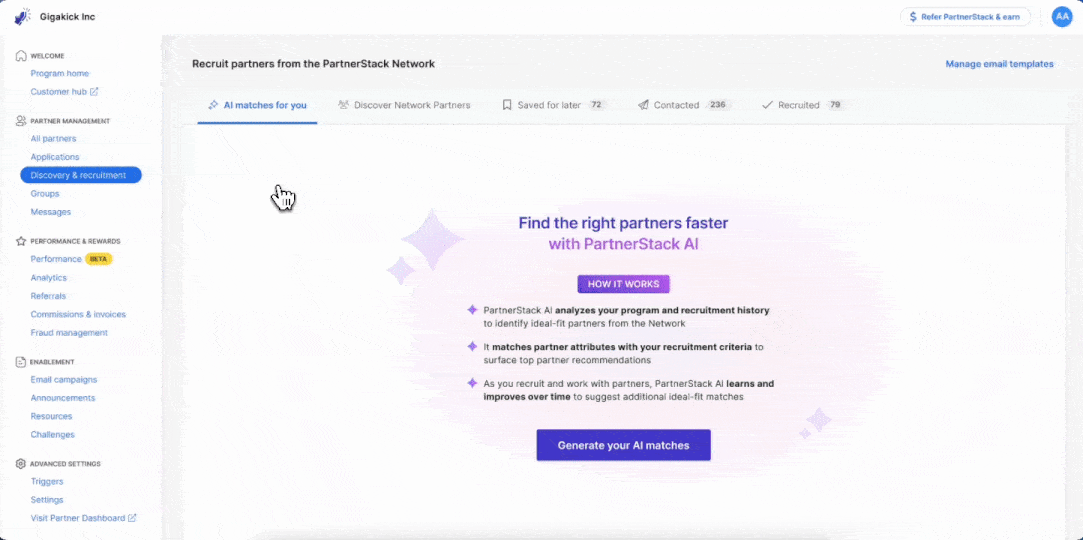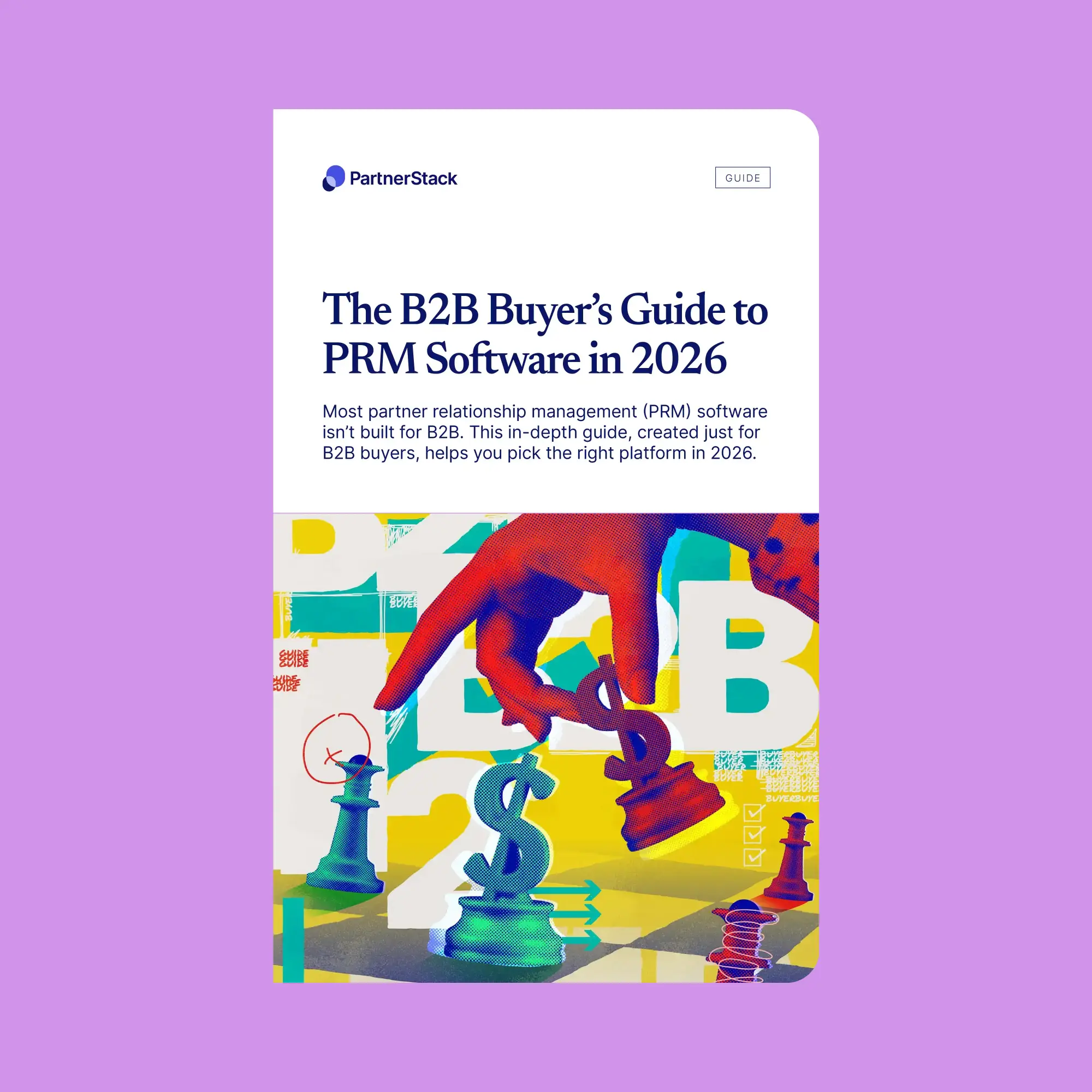Successful partner ecosystems hinge on a key factor — having partners. But, how? Recruiting partners doesn’t have to be hard — there’s a process for it, including tried and true partner recruitment steps that will help you gain your first revenue-generating partners.
It’s clear that partnerships can be lucrative and a great way to win at growth, scale and revenue. The over 120,000 partners in the PartnerStack network have seen more than $2 billion GMV in sales through the network, and according to a 2025 report on B2B trends from Partner2B, 58 per cent of revenue for top-performing companies comes from partners.
These days, partnerships is more than a channel. It’s GTM fuel. In modern B2B, winning isn’t just about having the best product or the loudest marketing. It’s about who can activate trust and relevance fastest — and that’s what partners do. Rather than treating partnerships as a standalone team or function, we embed them across your entire GTM stack.
Because it’s a long-term strategy, not a short-term play, getting partnerships up and running takes some foundational work before it evolves into a sustainable ecosystem that thrives with automation and smart integrations.
The secret to partnership success is determining the right course of actions to take, knowing who you are as a business partner in B2B SaaS and finding the right partners to generate success together. Just a match made in revenue.

The first 100
Launching a partner program can seem daunting at first — but once you learn the steps necessary to set yourself up for success, it’s a simple matter of process that builds confidence over time and program milestones. Throughout this guide, we will show you how. From identifying your ideal partner type to building incentive programs to recruiting the right partners, setting up your ecosystem properly is key for your revenue-driving success. With focus, time and a growing knowledge of partnerships and how they work, recruiting the right partners is an inevitability that provides more ROI to your business.
The strategy works — just ask the more than 600 B2B SaaS brands in our network or look at the $77M in commissions they earned last year — and launching partnerships within your organization now is your best course of action to bring the power of a good partner program to your bottom line. The trick to enjoying value-generating partnerships within your ecosystem comes down to selecting the right partners to work with.
To help you achieve the success you deserve for your partner program, we’ve put together this comprehensive guide on exactly how to find and recruit the right partners. Think of it as the only partner playbook you’ll need to get you to your first 100 (and one) partners.
In this guide for new partner program managers, we will:
- Identify your ideal partner type
- Build your partner commission structure
- Recruit the right partners for your partner program
- Set up your new partners for revenue-driving success
- Provide the right resources for your partners

Step 1: Identify your ideal partner type
The first question you need to answer before you can launch any partner program: what kinds of partners do I want to work with?
Deciding which partners are the best fit to start with depends on the goals of your partner program. All partner programs are designed to drive revenue, but have different paths to getting there.
Types of partners for your partner program
These are common partner types for you to consider when getting started with your partner program.

Affiliates
Affiliate partners, including individual affiliates and agencies, promote your product by driving traffic back to your website and landing pages through unique, trackable links. The primary ways affiliates do this are through content creation and paid advertising targeted at your ideal customers.

Influencers
B2B influencers have subject matter expertise — plus followers who convert. Because they’ve built credibility with their audience, they can help your brand stand out by putting a trustworthy face to it. They often work like an affiliate partner, driving traffic back to you and earning commissions, but you can also opt to pay a flat fee upfront to B2B creators for content creation to support awareness for your brand and product.

Referral partners
These are customers who already use your product, so they know first-hand who it’s for and why it’s valuable. Your customers can become affiliate partners and share a unique link back to your site, or they can send qualified leads directly to your sales team to work on. PartnerStack offers a referral widget that generates links and makes it easy to turn your customers into advocates, similar to PartnerStack’s own Refer-a-Friend.

Co-sell Partners
Agencies, consultants and tech partners help their clients find or directly provide SaaS products and services — which is a great opportunity for them to refer those clients back to you. These types of partners can introduce their clients to your product, position it as part of their overall offering and send a handy referral link or email introduction. Co-sell partners can even refer on PartnerStack via integrations with tools they use every day, like HubSpot or Slack.
What about strategic alliances?
As you scale up your ecosystem, you might consider other types of partnerships, such as strategic alliances, in which two companies with complementary products or services work together for mutual benefit, often through integrations.In this guide, however, we're covering how to recruit partners for your ecosystem that market and sell your products on your behalf and directly drive revenue to your business. When you're just getting started, it's important to keep things simple.

Which partner type is right for your business? Hint: Keep it simple, start with one.
Each type of partner is uniquely valuable — but if this is your business’ first partner program, it’s important to focus on a single type of partner to start with. Partner programs take resources to run, and you’re likely to learn a lot from your first program that you can apply to every program you launch in the future. Recruiting partnerships from one category and launching with a specific partner type allows you to track your progress and success to best support your partnership strategy and the tactics you’re employing.
- Your main goal is generating qualified leads, or signups if your product is free to start
- Your website is effective at converting traffic into leads and signups
- You want to grow your brand presence online
- You’re targeting Gen Z or Millennial buyers, who may not trust traditional tactics or sales reps
- You want to put a face to your brand that can bring your products to life
- You’re looking to expand into new regions where influencers and creator partners may already be established
- You have an active customer base that loves your product and will advocate for it
- Your product is low cost or easy for an individual to start using
- Your target customers often hire agencies or consultancies for support or have tech partners
- Your product can add value to agency and consultancy offerings
- Your product integrates with or complements other SaaS offerings
- Your main goal is generating qualified leads, or signups if your product is free to start
- Your website is effective at converting traffic into leads and signups
- You want to grow your brand presence online
- You’re targeting Gen Z or Millennial buyers, who may not trust traditional tactics or sales reps
- You want to put a face to your brand that can bring your products to life
- You’re looking to expand into new regions where influencers and creator partners may already be established
- You have an active customer base that loves your product and will advocate for it
- Your product is low cost or easy for an individual to start using
- Your product can add value to agency and consultancy offerings
- Your product can add value to agency and consultancy offerings
- Your product integrates with or complements other SaaS offerings

When you’re ready to dive deeper into partner personas, we’ve got you covered with a full guide and a free template for you to use.
Learn how to build personas — and get a free template: Building Partner Personas (for More Profitable Partnerships).
Step 2: Build your partner compensation model
Partnerships can provide immense value to your business in terms of accelerating customer acquisition and revenue — but for that to happen, your business needs to provide value back to partners to keep them motivated.
Unsurprisingly, commissions are the key to almost every successful partner program. The more partners can earn from promoting your product, the more likely they are to dedicate their time and resources to promoting it. Let’s be honest, incentives work.
That means the commission structure you choose for partners is one of the most important decisions to make for your program’s success.
What types of conversions will you commission partners for? Hint: They should be tied to revenue!
For SaaS partner programs, you should usually only offer partners a commission when they drive paying customers back to your business.
Some partner programs, especially in the B2C space, will give partners a commission for driving clicks or free signups. Best practices in B2B are a bit different — for instance, you should generally avoid paying partners for conversions that don’t correlate to revenue because:
- Non-revenue generating conversions can hurt the profitability of your partner program. Giving partners a commission only when they produce paying customers ensures that you’re not losing money paying partners, because the commission should always be a fraction of the amount the customer pays.
- Non-revenue generating conversions are much more prone to fraud. Affiliate programs can unfortunately attract bad actors who are just looking to make a quick buck. Giving partners a commission based on clicks, lead conversions, or free account signups opens the door to partners submitting fraudulent conversions through their links. Paid transactions are significantly more difficult to fake.
Instead of paying for non-revenue generating conversions like clicks, leads and free signups, consider focusing on giving partners a commission primarily when they drive paying customers to best safeguard your business.
If you still want to give partners a commission for qualified leads, be sure to closely monitor the conversions partners are driving to ensure their legitimacy and if those leads are leading to conversion across the funnel where partners are attached.

To tier or not to tier: Should you tier your partner program?
Many partner programs use tiers to motivate partners to drive more business. Partners who sell more get access to higher tiers, which typically have more benefits including higher commission rates.
Don't focus on tiers to start
Tiers add many complications to a partner program, as you have to consider:
- What is the right rev share amount for each tier?
- What are the criteria for upgrading partners between tiers?
- What benefits beyond additional commissions can I provide higher-tier partners?
That’s why although tiers are a common part of partner programs, we recommend that new programs ignore tiers and instead focus on delivering a single compelling offer for their ideal partner persona.

Step 3: Recruit the right partners for your program
After selecting your partner type and building out your commission model, you’ll be ready to start recruiting partners. Finding the right partners for your program is key to a thriving partner program.
There are two types of partner recruitment:
- Inbound recruitment: where partners discover your program themselves
- Outbound recruitment: where you reach out to partners to invite them to your program
- Your partnerships landing page on your website
- PartnerStack Marketplace
- Inside your product (for customer referrals)
- Searching on popular platforms (e.g. Google, YouTube, LinkedIn, Substack, usually to recruit B2B influencers)
- PartnerStack’s AI Matches, our intelligent partner discovery tool
- Competitors’ partner directories (for co-sell partners)
- Your existing customer contacts (for referrals)
- Your partnerships landing page on your website
- PartnerStack Marketplace
- Inside your product (for customer ambassadors)
- Searching on popular platforms (e.g. Google, YouTube, LinkedIn)
- PartnerStack’s partner discovery tool
- Competitor’s partner directories (especially for agencies and consultancies)
- Your existing customer contacts (for customer ambassadors)
Between inbound and outbound recruitment, which should you focus on first? The answer is both!
Inbound and outbound recruitment are two halves of a single solid partner recruitment strategy. If you rely entirely on inbound partner recruitment, you’re likely to see a slow start to your program as it takes time for word to spread and reach your ideal partner persona. Outbound recruitment can be incredibly effective and is especially valuable at kickstarting your program early — but it’s difficult to scale up and won’t reach everyone.
Inbound recruitment
Get set up by creating a partner program presence on your channels and website.
Build your partner landing page
The most important part of your inbound recruitment strategy is having an effective landing page for partners on your website. Your landing page should make it clear who your program is for and what the benefits of participating in it are.
For most potential partners, the key benefit is earning money — no surprise there! — so don’t be shy about your compensation model. It’s also helpful if you briefly outline what you’re looking for, whether that’s affiliate recruitment or influencer partnerships, because creators don’t want to wade through the benefits for co-sellers and vice versa.
If possible, it’s always best to have your landing page written and designed by professionals, so that it reads clearly and loads quickly. After all, potential partners like affiliates and influencers are usually professional content creators themselves, so a high-quality landing page signals that you’re playing in the same league.
What to put on an inbound partner recruitment landing page
This copy template for partner program landing pages is created by PartnerStack, and is free to use for anyone.
Some questions that partners will have:
- How much can partners earn?
- Who is your product’s target audience?
- How do partners get paid?
- What resources support partners’ success?
- Who is a good fit to be a partner?

Get listed in the PartnerStack Marketplace
The PartnerStack Marketplace promotes your program to thousands of partners that already use PartnerStack to earn money by driving business and revenue for SaaS companies like yours.
Every program on the PartnerStack Marketplace comes with its own landing page that links directly to your application form, making it easy for partners to apply to join. (We still strongly recommend having a separate, dedicated landing page for your program on your website!)
Partners can also explore programs to join directly from within their PartnerStack dashboard.
The PartnerStack Marketplace drives millions in revenue for PartnerStack customers every year, with some programs seeing more than 30% of their entire program revenue come from partners that joined through the PartnerStack Marketplace.
Reach potential advocates inside your product
Want to convert your customers into advocates? The best way to reach the people using your product is directly inside your product!
PartnerStack’s referral widget can be embedded directly inside of your product, giving your customers one-click access to their unique referral link. They can share that link anywhere and earn commissions whenever they drive conversions for your business, based on the compensation model you choose.
After implementing the referral widget — which took less than a week — Apollo saw a 100% ROI after three months and more than 500 new partners via the widget after four months.

Outbound recruitment
Here’s how to find partners who are a good fit — and what to say when you reach out to them.
How do you get started on outbound recruitment? Use search and an AI-powered solution
Want to know how to use AI to find partners to recruit? We’ve got a tool for that, too. Learn more about AI Matches within the partner discovery tool.
Get search and answer engines to point you in the right direction
Explore the internet for opportunities to sniff out the right partners for your partner program. Search on Google for top terms:
- Search for your own target keywords. Chances are you already have a list of target keywords you want your website to rank for in order to reach your customers. Check to see what pages and articles show up in the top results for those terms — there’s a good chance that some of them come from potential partners!
- Search for “Top X software for Y” listicles. Articles that cover top software within a specific category are often popular and rank well on Google and are often cited by LLMs. If these articles exist for your space (and they likely do), being listed within them can be a huge source of traffic and revenue. If you find relevant articles where your product isn’t mentioned, reach out to the author and see if you can get added! Even if your product is there, encouraging the author to switch to using affiliate links so they can earn revenue from conversions they drive can make them more likely to feature your product in the future.
Example: PartnerStack on ‘best of’ lists
Search “best partnership relationship management software” or “best PRM software,” and the top-ranking results are for lists from third parties like Gartner, G2 and Channel Insider that all mention PartnerStack.
Being on a “best of” list adds credibility, plus most lists will highlight some of the top features of every product they name — basically doing the selling for you. The G2 list, for example, cites reviewers who say PartnerStack is intuitive and easy to use. Because it’s coming from a third party, the praise reads as authentic. And because the lists are right on the first page of Google results, they’re a big source of traffic.
Take advantage of Google’s “People also ask” suggestions, which are often listed at the bottom of the first page of search results. Explore as many search terms as possible to find more relevant partners!
Don’t just think about keywords, think about questions people are asking as they search. Again, Google will often help with this by including an AI overview answer at the top of search results and a “People also ask” section farther down the first page. The more you dive into the questions, The more you dive into the questions, the more likely you’ll discover a partner that could be the right fit.


Find B2B influencers in your industry
Influencer-led partnerships can be great because B2B influencers come across as knowledgeable and authentic. Here’s how to find them:
- Check LinkedIn to see who’s writing newsletters about your area or products like yours.
- Search X/Twitter or podcast lists for suggestions on content creators who cover your industry, or browse content on YouTube, Reddit and Substack.
- Build your list of potential partners using audience research tools like SparkToro.
Starting is the hardest part — once you’ve explored the influencer landscape a bit, you’ll get more recommendations for similar content (thanks, algorithms).
Find out who’s partnering with companies like yours
It’s common for partners, especially affiliates and B2B influencers, to promote multiple products within an industry. Partners that would be a good fit for your program are likely to already be promoting other products in your space — like your competitors.
That’s an opportunity for you though, because it’s easy to find partners that are already working with other companies in your space and invite them to your program. Here’s how:
Find potential partners already linking back to your competitors. Use a search engine optimization (SEO) tool like Ahrefs or Semrush with the ability to check backlinks and see which pages link back to a competitor’s site. You can review this list of backlinks to find affiliate links leading to your competitors. Adding “?” to your backlinks search will show only results that have unique identifiers — like UTM tags or affiliate codes — making it easier to find relevant results.
Look for partner directories on your competitors’ websites. As a benefit to partners, many businesses will provide directories of partners on their websites so that prospects and customers can reach them directly. Check competitors’ websites for partner directories and reach out to them! (Just make sure to contact them directly yourself, and not through a form on your competitor’s site.)
You can also use these tips to find partners of complementary tools or products you integrate with. As a bonus, partners who are already promoting similar software are likely familiar with your product as well as affiliate programs in general — meaning less of an onboarding lift for you.
What to say in an outbound recruitment email
Your search time paid off, and now you’ve got a list of potential partners who are (probably) just waiting to hear from you. It’s time to reach out — but how? Here are four templates with example emails to introduce yourself to prospective partners.
All four emails mention the vendor’s bona fides (brands served, awards won, pain points addressed, etc.) and benefits for the partner (commission model). If you write your own outbound recruitment emails, make sure you show that your company is legit and let the recipient know that there’s plenty in a partnership for them, too.
Use PartnerStack’s AI-driven partner discovery tool
We already covered the PartnerStack Marketplace, which promotes your program to thousands of partners already using PartnerStack. There’s another way PartnerStack makes finding the right partners smarter and faster than ever: AI Matches, our intelligent partner recruitment solution.

Using AI Matches in PartnerStack’s discovery tool, your ideal partners are brought directly to you, making it easy to connect with high-fit partners in just a few clicks. The tool also surfaces all the key information you need to evaluate a partner so that you can see what makes each partner a match, fast.
Between the PartnerStack Marketplace and partner discovery, PartnerStack is the only partnerships platform that supports both inbound and outbound B2B partner recruitment.
Create your partner application form
The majority of your partners, both inbound and outbound recruited, will likely join your program by submitting an application.
Your partner application form is a great opportunity to ask questions and learn a bit more about your partners before you approve them to join your program. That said, you want to avoid making your application too long or difficult to complete, as this can lead to reduced applications.

- What country are you based in?
- Which of the following best identifies you:
Agency/consultant
Review/comparison site or blog
Software/tool for businesses
Course instructor
B2B influencer
Affiliate marketer
Other
- How do you plan to market [our brand]?
- Which website will you primarily drive traffic from?
- How large is your audience?
- What do you need to be a successful partner?
- How did you discover [our brand]?
PartnerStack makes it easy to build application forms and manage all your incoming partner applications.
Build branded application forms simply by choosing which fields you want your form to have.
Manage all of your applications from inside PartnerStack, which makes it easy to review applications quickly and even bulk approve or reject applications.
Step 4: Set up your new partners for success
Once your partners are in your program, they’re good to go, right? Not exactly. Applying to join a partner program is easy to do. Actually succeeding in it is more challenging. If partners don’t feel motivated as soon as they enter your program, you’re likely to quickly lose their attention.
This is where partner activation comes in. An activated partner is a partner that’s driving measurable success for your program, however you choose to define it (although typically it means they’re driving sales and revenue).
The two most crucial steps to activating your partners are:
- Onboarding your partners (ideally with automation)
- Providing partners with useful resources
Automate your partner onboarding (for smooth operations)
Making sure your partners feel welcomed into your program, and have the information they need to get started right away, is one of the easiest and highest-impact ways to improve your partner activation.
When you first start your program and have only a handful of partners, it’s feasible to give all of your new partners personal 1:1 onboarding. As your program scales up and the number of new partners increases, you’ll want to start automating your partner onboarding with emails based on your partners’ activity so far.
The three most common types of partner onboarding emails are:
- Welcome emails: Emails your partners receive when they join your program
- Inactivity emails: For when partners aren’t showing activity right away
- Progress emails: Message that acknowledge and celebrate your partners’ progress
Tracking the progress of all of your partners and sending each of these types of emails manually would be extremely difficult and time-consuming. Thankfully, PartnerStack includes everything you need to build and send automated emails to partners depending on what they do (or what they don’t do).
Welcome emails
You should always send an email to your partners as soon as their application to your program is approved. Some things you can include:
- Your partner’s unique referral link (if you run an affiliate or referral program)
- Reminder of how your compensation model works and how partners can earn money
- Link to a useful high-level resource, like an FAQ for your program
You don’t have to limit yourself to just a single welcome email. If you have more useful information to share with partners, you can send them a few emails within the first few days.


This activity can look like:
- Your onboarding emails are being opened
- Resources are being viewed or downloaded
- Affiliate links are getting clicks
- Partners are reaching out with questions

Get free ecosystem advice
Inactivity emails
It’s likely that many partners will join your program but show no activity early on. Emailing inactive partners with useful resources and tips on how to get started can make the difference between them never showing any results, or becoming future top-performers. Strong partnerships start at engagement.
PartnerStack makes it easy to target automated emails at inactive partners, which are partners that have either not visited the partner portal or have not driven any leads, sales or signups within a set period of time.
It’s most common to email inactive partners after seven, 14, and 21 days of inactivity. In these emails, you can:
- Ask if they need help getting started — sometimes prompting a partner to reply to you is the best way to get them to activate
- Link to more in-depth resources, like information about your customers or templates they can use when promoting your product
- Share success stories of other partners in your program, with tips on how to achieve similar results

Progress emails
Celebrating the progress your partners make early on in your program can motivate them to keep moving forward. Automate emails to send to your partners when they hit specific milestones, like:
- When their link starts getting clicks — even if those clicks haven’t converted yet, it lets partners know their links are getting attention
- When they drive their first free signup
- When they drive their first paying customer






Step 5: Provide the right resources for partners
FAQ for partners
In a survey of over 1,000 partners using PartnerStack, partners rated a partner program FAQ as the #1 most important resource partner programs can provide. Having a single document that covers the need-to-knows of your program makes it way easier for partners to get started. This can:
- Remind partners how your compensation model works
- Tell partners where to get their referral link(s)
- Give partners examples of top keywords and strategies
Visual brand assets
Don’t make your partners search Google for “company name logo png” or screenshot parts of your website whenever they need visuals to feature your product. Make life easier for your partners, and ensure they stay on-brand by giving them the right assets to use right away.
- Your company logo, including any variants (e.g. logo vs. logotype, light and dark version)
- Product screenshots and mockups
- Display ads in a variety of sizes

Boilerplate messaging
Similar to visual brand assets, if you don’t provide messaging for your partners to use, they’ll have to trawl through your website to find something usable or come up with their own messaging for your product. Consider including:
- Short, medium, and long descriptions of your product/company
- Descriptions of specific features
- Information on plans and pricing (this is something you really don’t want partners guessing on)
Customer personas
Ideally, your partner landing page, welcome email, FAQ and other resources should give partners at least a high-level idea of who your customers are — and by extension, who they should be marketing and selling your product to.
Go deeper with customer personas and share these insights with your partners. Detailed personas help partners:
- Better understand your customers and their needs
- ProvidFind the overlap between your ICP and their audience — which, thanks to the conversion-based compensation model you’ve chosen, benefits both of youe insights into how your product solves their problems
- Provide insights into how your product solves their problems
- Supports them to be more effective when marketing and selling your product


However, if you have a complex product, or want to empower partners to resell your product to end customers on their own, it’s worth considering how a complete training course could better enable your partners to succeed.
Learn more in our article:
Why Partner Education Can Make or Break Your Program
Conclusion
The 5 key takeaways as you prepare to launch your partner program
Let’s be honest, this is a lot to take in as you prepare for your big launch. But this guide exists to help you throughout each milestone as you set your partner program in motion. The next time you’re sniffing out best practices for recruiting your partners, you can reference each section of this guide to support your good work.
Staying in the know with partnerships ecosystems is an always-on for us here at PartnerStack. To best launch your partner program, we encourage you to keep these five things top of mind:
- Partner programs are unique, but they all build trust. Each program is as unique as the person running them, but building customer trust is something they all share. And in today’s B2B landscape, being able to call on partners to establish trust between customers and your company is more valuable than having the shiniest product or the flashiest marketing.
- Partner programs are a long game. While it’s possible to see some quick wins, it’s important to level-set expectations because a successful program is not born overnight. Give partners time to go from having links clicked to scoring their first conversion to driving their first thousand in revenue.
- Recruiting the right partners matters. But that doesn’t mean you have to nail down your ideal partner persona right away. Instead, focus on one type of partner to begin, whether affiliates, influencers, customer referrals or co-sell partners, and build out your persona as you learn from each new partnership.
- Inbound and outbound recruitment strategies work together. You need both. Create a useful partner landing page on your website, make sure you’re listed in marketplaces and use both search and social to find the best partners for your business. And don’t forget the referral widget!
- An excellent partner experience is key. Making your partners’ experience as smooth as possible is critical — but not difficult. Automate your onboarding with PartnerStack, then make sure you support partners with brand assets, information about customer personas and company messaging.
Keep the partnerships conversation going. Markets change at a rapid pace — and what works in the first quarter of the year may not in the third. Stay in the know by following industry thought leaders, keep up to date on fresh resources and stay engaged in the partnerships space.
Automating and scaling is made easy through PartnerStack’s ecosystem. After recruiting and activating your partners on our platform, your partner program is ready to launch so you can enjoy the revenue and benefits in half the time and usual cost.
- Partners drove more than $693M in revenue in the last year alone
- There are now more than 120K+ partners commissioned through PartnerStack’s B2B SaaS network
- In total, more than $2B of sales (GMV) have come through the PartnerStack Network
- The average time to ROI with PartnerStack is just 8 months, which is 33% faster than competing PRMs
We are invested in every stage of partnerships growth. As your partner program launches and grows, the PartnerStack ecosystem can power every kind of partnership — from co-sell, to B2B influencer, to referral — and make it easy to run multiple programs side-by-side to diversify your own ecosystem.
At the end of the day, we’ve got your back. And remember, this isn’t just on you — it’s called partnerships — you can’t do it alone.









.webp)











